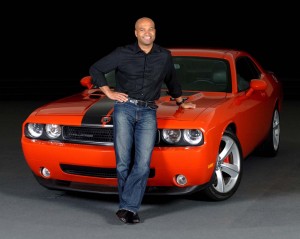While fuel prices may be hovering near record levels, there’s plenty of demand for performance – or so Chrysler is betting as it readies the ambitious re-launch of its SRT brand.
The make is rolling out four new SRT models that have been equipped with a new 6.4-liter hemi-engine that delivers not only better performance but also markedly improved fuel economy compared to the old Chrysler 6.1-liter Hemi.
The engine in each of the cars has been equipped with cylinder de-activation technology that Chrysler claims can boost mileage by as much as 25%, while upgraded vehicle dynamics, performance-oriented brakes and race-inspired seats – as well as a new high-end sound system – should appeal to traditional muscle can fans.
The 6.4-liter Hemi V8 produces 470 horsepower and 470 lb-ft of torque and can propel the SRT versions of the Dodge Challenger , Dodge Charger and Chrysler 300 to top speeds of 175 mph. The SRT version of the Jeep Grand Cherokee with its 20-inch, highly stylized wheels – designed to show off the new Brembo brakes – tops out at “only” 165 miles per hour after the vehicle’s ground clearance was reduced by an inch to make the SRT SUV more aerodynamic.
Ralph Gilles, the new President of Chrysler SRT Group and Chrysler’s corporate chief of design, reluctantly approved a fully functional spoiler for the rear deck of the 300 after his engineers successfully argued the car needed it to help maintain high speed stability.
The whole point of elevating the status of the SRT — or Street Racing & Technology — Team was to showcase commitment to both performance and design, Gilles said. “These cars showcase the underlying strengths of the foundation cars,” he explained, contending that each of the four vehicles selected for the SRT showcase is very strong to begin with.
The launch of the new SRT line also will help pave the way for the much-anticipated re-launch of the Dodge Viper with its V10 engine. The reborn 2-seater, developed in partnership with Fiat, will debut next year.
With the auto industry putting so much emphasis on fuel economy and small cars, some might question the decision to not only maintain big vehicles like the full-size 300 but then add a high-performance version.
Gilles insisted there is a substantial business case behind Chrysler’s decision to upgrade SRT, which has been part of the maker’s portfolio since 1992. Chrysler has sold 165,000 SRT models since the early 1990s and the performance line has attracted customers that the Detroit maker would not have reached without the SRT label. They’re then more likely to lean towards Chrysler products when they’re shopping for another, less exotic vehicle, Gilles said.
“There are no direct competitors for these cars,” he said, adding that this helps make the line quite profitable.
As a group, SRT owners are enthusiastic and have regularly contributed new ideas on how to improve the cars and their performance.
Chrysler isn’t planning any kind of advertising blitz but instead will count on word-of-mouth and social media to help spread the news about the 2012 SRT lineup.
“We’re going to emphasize the customer experience post-sale,” he said by bringing new owners into the SRT family. “We’re going to do more events for them,” said Gilles, who noted SRT has already expanded its special web site about six weeks ago to get ready for the 2012 launch.
The webs site will also feature access to SRT engineers and designers, he said. “I’ve been going to a lot of car shows, “he said. “This is all about the passion.”

